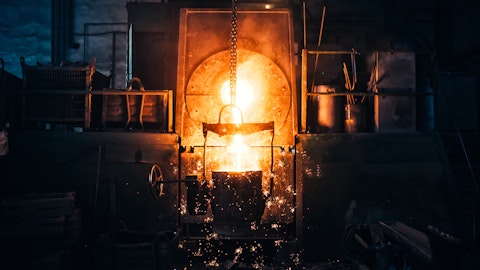Jordan Levy: Very helpful. Thank you.
Todd Becker: Thank you.
Operator: Next question comes from Eric Stine, Craig-Hallum. Please go ahead.
Eric Stine: Good morning everyone.
Todd Becker: Good morning.
Jim Stark: Good morning.
Eric Stine: Hey, just going back to 60 Pro, I mean, is this a matter more of the market or your place in the market developing? I mean, is there any reason as we think long-term that your entire platform isn’t 60 Pro? And just to confirm, I believe you said fit in the near-term, you are hoping 20% to 30% would be 60 Pro.
Todd Becker: It’s why we built them, Eric. I mean, we didn’t build our systems to run 50 Pro. We built them because we knew with our partnership with Fluid Quip and our investment there that we’ve made and the amazing technology they have and the consistency of their product and the way it flows and the way it looks and the color of it, it’s very different than any anything else available on the market. The way we dry it, the way we process it, it’s just consistent. We have no problem consistently making 50, 52 anything we want to make on demand and gaining large our yield increases, which is why we did it as well. But we bought Fluid Quip and we invested in Fluid Quip with our partners to make 60% protein and more and greater and so our whole platform and our whole marketing efforts getting into 2024 and 2025 have been to maximize our market penetration in 60% protein.
And that’s where we believe we’re heading when we look at a new plant and where we want to build the next one. We basically have to say if we push yield and we push protein, we also know that what is our fiber product going to look like as well, because we are creating new products, we are creating yeast products, we’re creating fiber products when we make 60 Pro, it’s a very different outcome. But yes, our intent and our plan is to go as far as fast and as quickly as we can in the highest amount of volumes to move to a 60 Pro market. And we are focused on doing that. It will take a while because it has to be a global outcome. And so now we’re working with partners globally as well for distribution and talking with potential partners on distribution as well, because you’re going to have to this is a global product and we think that’s where the best places to really get max penetration against products.
Everything from corn, gluten meal to soy protein concentrates, all the way to what we’re doing on our biological opportunities in terms of taste and texture and profiles to even start to think about things like fish meal replacement as well. And that’s really where – that’s the ultimate Pandora’s box that we continue to try to solve for every day.
Eric Stine: Got you. And then I mean, I guess not to totally try to pin you down, but I mean, in terms of timing, you said it’ll take a while. I mean, is that two, three years out or is that it’s going to take five plus years?
Todd Becker: No, it’s not five years. I can assure you – I mean, I can almost assure you of that, every time I say I can assure you it’s probably not the best thing to say, but it’s not five years out. I mean, our program has fully been designed and the people we brought in to help market this product and sell it all have experience at the higher protein levels and customer base. So it’s just time. It’s not going to be matter. And our view, it’s not a matter of if, can we do the whole thing? We should be able to, I mean, there’s 10 million tons of demand globally, if not greater than just for things like corn, gluten meal and more for corn, or soy protein isolates and soy protein concentrates and those type of things. And we brought a new leader to the team that came out of Cargill that spent his time globally in different protein and aquaculture businesses.
And he’s now running our protein marketing as well. And so we’re tracking that type of talent to this company so that, when they show up at the door, they have great customer relationships, but also a lot of credibility from where they came from to where to where we’re going. And we’ve built teams around all of our products, clean sugar and protein. Cornell’s a little easier. They just call and they buy it. But in those products we wanted to make sure that we staff those with deep technical and marketing experience and that this really didn’t exist in the Gen 1 industry. So we’re tapping that from all of our larger counterparts in agriculture and energy.
Eric Stine: Okay. Thank you.
Todd Becker: Thank you.
Operator: Our last question comes from Andrew Strelzik from BMO Capital Markets. Please go ahead, Andrew.
Unidentified Analyst: Hey guys, this is Ben on for Andrew. Just one quick one on the ultra-high protein EBITDA build. Todd, I think you alluded to this earlier, but you guys seem to still be on track for $150 million run rate by the end of 2024. If you could just briefly kind of walk us through the path as to how that looks. Obviously, we’ve heard a bunch on 60 Pro at the beginning of the year, but just trying to bridge that gap into 2025. Thanks.



